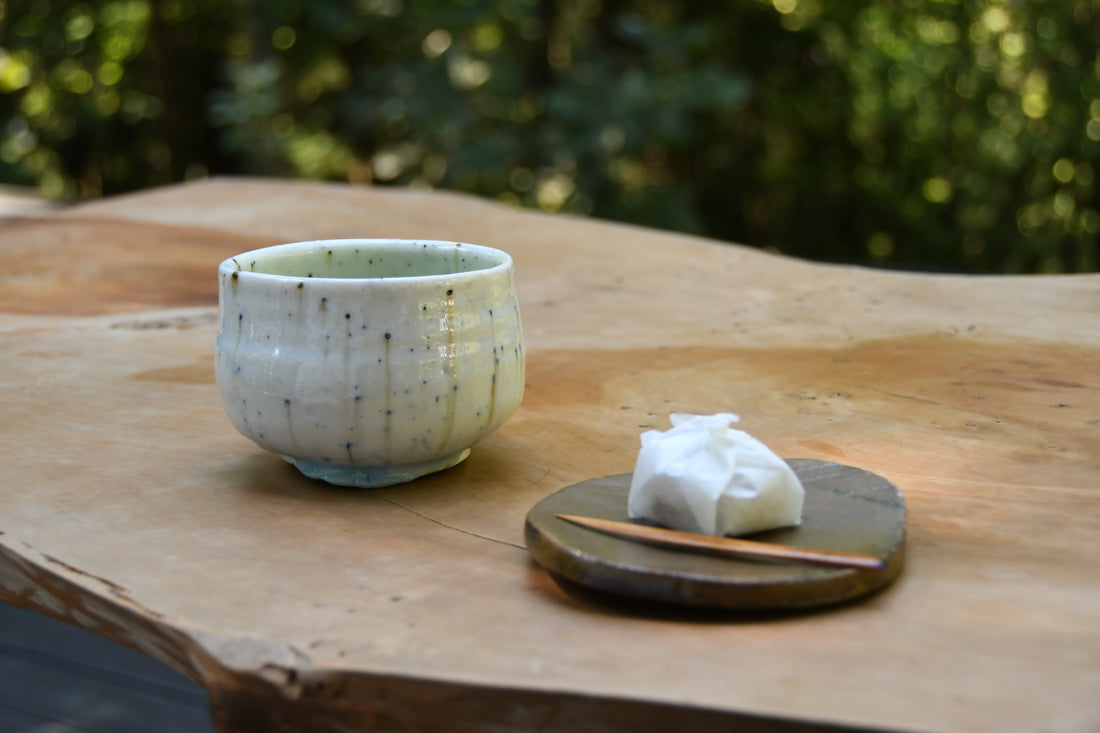
Artist Visit - Hirohisa Kondo
Share
The Shinkansen takes just an hour and a half to travel from Tokyo to Nagoya. From there, I hopped on a local train to Mizunami Station—a charming little stop that instantly brought back memories of slower, simpler times. Mr. Kondo himself waited by the ticket gate with a warm wave and a big smile.
We got into his car and headed uphill toward his studio. Flanked by lush greenery and nostalgic countryside views, the road gradually narrowed until it became more of a mountain path. At the top sat two houses—one a traditional thatched-roof home belonging to his father, the other a modern, log-house-style residence where Mr. Kondo lives with his family. A bright, open living room welcomed me, where I met his wife and their adorable 7-month-old baby. We moved out to the deck, where our conversation began.
 Mr. Kondo didn’t always intend to become a potter. In his younger years, he was obsessed with cars—he still is—and worked in customizing vehicles. But having grown up watching his father at work, pottery was always, perhaps quietly, part of him. In his late twenties, he leaped and asked his father to teach him. His father accepted without much talk, guiding him with a quiet but steady presence.
Mr. Kondo didn’t always intend to become a potter. In his younger years, he was obsessed with cars—he still is—and worked in customizing vehicles. But having grown up watching his father at work, pottery was always, perhaps quietly, part of him. In his late twenties, he leaped and asked his father to teach him. His father accepted without much talk, guiding him with a quiet but steady presence.


One day, his father simply said, “This is good.” And just like that, Mr. Kondo held his first solo exhibition. From there, he began reaching out to galleries and shops on his own to showcase his work.
What’s truly fascinating is that Mr. Kondo begins his process of making the soil. Sometimes, he uses clay from around his home and other times; he travels as far as Kagoshima in search of just the right earth. Clay, after all, is never just clay—it varies in texture, color, grain, and mood, much like people. He even makes his glazes, gathering plants from the forest behind his home and spending weeks extracting their essence without using any machinery. He lets nature do its quiet work, then carefully collects only the clearest layer.


Only after all this preparation does he begin shaping. Up to 100 pieces—big and small—are loaded onto long wooden boards and carried into the kiln.
His kiln is a traditional Noborigama, or climbing kiln, inherited from his father. Built into a slope, it stretches 5–6 meters long and is just tall enough for a person to crawl inside. The front part is accessed directly, while the middle and back sections are loaded through side openings. The placement of each piece matters—it affects how the fire moves around it and, ultimately, how the piece turns out. Once the firing begins, Mr. Kondo tends the kiln day and night for four to seven days straight. No shortcuts.
Next to the kiln, I noticed shelves of beautiful pieces. “Are these for your next exhibition?” I asked.
He laughed. “Most of these are failures.”
Only about half—or sometimes even less—of what goes into the kiln comes out exhibition-ready. Many of the “failures” looked perfectly fine, even beautiful, to my untrained eye. But Mr. Kondo sees every subtle flaw, every slight deviation in color or texture. Of course, using electric or gas kilns where conditions are easier to control would be more efficient. But for him, the unpredictability of wood firing is precisely the point.
“Everything affects the outcome,” he told me. “Humidity, temperature… even the type of wood you burn.”
He said this not with frustration but with delight. The unpredictability isn’t a challenge for him—it’s an invitation.

Mr. Kondo isn’t afraid to try new things—new glaze recipes, different types of clay, and fresh designs. He looks beyond tableware to things like wall clocks and light fixtures. His perspective is wide—he’s thinking not just about plates but about how ceramics can be part of a whole way of living.
Traditionally, many Japanese ceramic artists dedicate their lives to perfecting a single form—a vase or a jar—and that deep focus has its own beauty. However, Mr. Kondo seems to add a new layer to that tradition: curiosity.
Looking again at the shelf of “failures,” I asked,
“After so many pieces don’t turn out as planned… what keeps you going?”
He paused for a moment, then said,
“Well… it’s just fun. I always think, ‘Maybe I’ll try this next time.’ That part is exciting. I still have so many things I want to try.”
You may have noticed something if you’ve been following along with these stories. Every artist I’ve spoken with so far has used the exact words to describe their craft:
Fun.
Interesting.
Exciting.
Perhaps that’s the quiet thread connecting them all—the joy of not knowing what will come next but creating anyway. These artists choose discovery and possibility in a world that often demands certainty and perfection. They embrace failure not as an ending but as a necessary step in the dance of creation. And maybe that’s what makes their work so alive. It reminds us that beauty doesn’t come from controlling the outcome—but from showing up, staying curious, and continuing to shape something with care and wonder.
